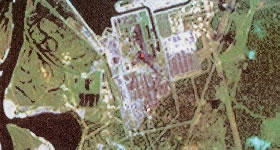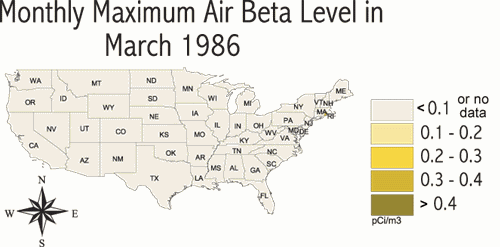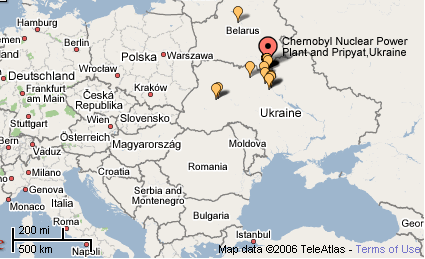Chernobyl Power Plant, Ukraine
Emergency Preparedness
and Response
On Saturday, April 26, 1986, reactor number four at the Former Soviet Union's Chernobyl nuclear power station, exploded and burned. The accident, which occurred during unauthorized testing, emitted large quantities of radioactive material. The heat from the fire was so intense that the glowing reactor could be seen even from space, as shown in the satellite photo at right.
The U.S. detected slightly elevated radioactivity levels, but they were well-below levels requiring protective actions.
On this page:
- How did EPA respond?
- How did EPA monitor the plume as it crossed the U.S.?
- How did EPA protect U.S. citizens in Europe?
- Chernobyl Disaster: An Inside Tour
- Resources
How did EPA respond?

Chernobyl Nuclear Power Station in April of 1986, with red glow of Unit 4 visible near the center.
In the days following the accident, the Soviets released little data on the severity of the accident and almost no data on the extent of radioactive fallout in Europe and the rest of the world. In response to Americans' concern about potential health effects in the United States, the White House designated EPA to lead the U.S. response. The Agency immediately took several steps:
- monitored radioactivity levels in the United States
- established a group to provide advice on preventing contamination of the food supply and protecting public health
- established an information center to gather and distribute facts and data about the accident
- arranged daily press conferences to keep the public up-to-date and give EPA an opportunity to answer the public's concerns.
How did EPA monitor the plume from Chernobyl as it crossed the U.S.?
One source of monitoring data was daily samples from EPA's RadNet predecessor, the Environmental Radiation Ambient Monitoring System (ERAMS). The system first detected radiation from the accident at ground level on the West Coast one week after the accident. Although radioactivity levels were somewhat elevated, they were fortunately well below levels requiring protective actions. The animated illustration below shows the path and the timeframe for the passage of the Chernobyl plume across the United States.

Monthly Maximum Air Beta Level in March 1986
How did EPA protect U.S. citizens in Europe?
In addition to its monitoring activities in the U.S., EPA sent experts to Europe to monitor and assess levels of radioactivity around U.S. embassies. Since then, EPA personnel have measured levels of radioactivity in the Black Sea and Kiev Reservoir under a cooperative agreement with the Soviet Union.
Chernobyl Disaster: An Inside Tour
Chernobyl: An Inside Tour (Slide Show)
Ten years after the 1986 explosion of Unit 4 of the Chernobyl Nuclear Power Plant near Pripyat, Ukraine, EPA staff member Gregg Dempsey was given a rare tour inside the Sarcophagus that surrounds Unit 4. His slide show from that visit offers a unique historical snapshot of the conditions and challenges inside the plant, providing views of the interior of Unit 4 not seen elsewhere in Chernobyl photo collections. In addition, it offers the personal perspectives of workers who were present at the time of the accident, one of whom returns to his flat in the nearby city of Pripyat for the first time since evacuating it 10 years earlier.

Chernobyl Nuclear Plant
and Pripyat, Ukraine: Location Within Europe
(Image courtesy of Tagzania, powered by Google Maps )
Clicking on the map brings up an interactive version which allows users to zoom into the Chernobyl area. Each orange marker indicates a particular location that previous users have identified and tagged.
![]()
Resources
- Back grounder on Chernobyl Nuclear Power Plant Accident
 (U.S. Nuclear Regulatory Commission)
(U.S. Nuclear Regulatory Commission)
This page describes the accident and provides links to reports on various facets of its aftermath. - Chernobyl Health Effects
 (U.S. Department of Energy )
(U.S. Department of Energy )
This page provides links to reports on the health effects manifested in those exposed during the disaster. - Researchers Determine Chernobyl Liquidators' Exposure
 (Lawrence Livermore Laboratory)
(Lawrence Livermore Laboratory)
This article describes how researchers use special techniques to monitor genetic damage in people exposed to ionizing radiation. - Maps and additional photographs of Pripyat, Ukraine and Chernobyl

This site provides a "zoomable" map with links to pictures. One "tagged" point is the Ferris wheel seen in several of the photos in the slide show. (Zooming in sufficiently reveals a view of the Ferris wheel and its shadow.) - Mobile Laboratory for
the Ukraine
describes the development of a mobile environmental testing laboratory for use by the Ukraine in the aftermath of the Chernobyl accident. - Chernobyl
Nuclear Power Plant Health Effects Resources

provides information and a registry for immigrants from Russia, Belarus, and Ukraine who were exposed to radiation after the accident at the Chernobyl.
![[logo] US EPA](https://webarchive.library.unt.edu/eot2008/20081106134520im_/http://www.epa.gov/epafiles/images/logo_epaseal.gif)